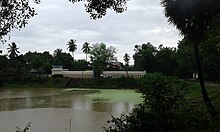Thiruthevanartthogai
| Thiruthevanartthogai | |
|---|---|
 | |
| Religion | |
| Affiliation | Hinduism |
| District | Mayiladuthurai |
| Deity | Madhava Perumal, Deivanayakan (Vishnu), Kadalmagal (Lakshmi) |
| Features |
|
| Location | |
| Location | Kiḻchalai |
| State | Tamil Nadu |
| Country | India |
| Geographic coordinates | 11°11′48″N 79°46′31″E / 11.19667°N 79.77528°E |
| Architecture | |
| Type | Dravidian architecture |
Thiruthevanartthogai or Madhava Perumal Temple is a Hindu temple dedicated to
It is one among the eleven Divya Desams of
Legend

The legend of all the eleven temples of Tirunangur are closely associated with each other. As per legend, the Hindu god Shiva started dancing in fury at this place after the death of his consort Sati due to the episode of the daksha yajna. Each time his lock of hair touched the ground, there were eleven other forms of Shiva who appeared. The celestial deities were worried that if the dance continues, it would result in decimation of entire creations. They prayed to Vishnu for help, who appeared at this place. On seeing Vishnu, Shiva's anger was reduced and he requested Vishnu to appear in eleven forms like he did. On his request, Vishnu appeared in eleven different forms at Tirunangur. The eleven places where Vishnu appeared are believed to be where the eleven temples in Tirunangur are located.[1] It is believed that the celestial deities had an assembly here at the temple.[2] It is also believed that sage Vasishtha is believed to have worshipped Vishnu at this temple.[3] As per another variant, Shiva requested Vishnu to appear in eleven different forms like him to control the eleven Shiva forms he created.[4] The eleven rudras, called ekadas rudras and king of devas, Indra, are believed to have worshipped Vishnu at this temple.[5]
Architecture
The temple faces west. It is located in Kiḻchalai, 6.5 km from
Religious significance
The temple is revered in
Worship practices and festivals
The temple is open from 8 a.m. to 10 a.m. and 5 p.m. to 7 p.m. The temple priests perform the puja (rituals) during festivals and on a daily basis. As at other Vishnu temples of Tamil Nadu, the priests belong to the Vaishnava community, from the Brahmin class. The temple rituals are performed four times a day: Ushathkalam at 8 a.m., Kalasanthi at 10:00 a.m., Sayarakshai at 5:00 p.m. and Ardha Jamam at 7:00 p.m. Each ritual has three steps: alangaram (decoration), neivethanam (food offering) and deepa aradanai (waving of lamps) for both Madhava Perumal and his consort Kadalmagal. During the worship, religious instructions in the Vedas (sacred text) are recited by priests, and worshippers prostrate themselves in front of the temple mast. There are weekly, monthly and fortnightly rituals performed in the temple.[6]
During the new moon day of the Tamil month Tai, the
References
- ^ R. 2001, pp. 470-1
- ^ ISBN 978-81-88661-42-8.
- ISBN 9788120601512.
- ^ a b "திருநாங்கூர் நாராயண பெருமாள் கோவில்" (in Tamil). 21 October 2019. Retrieved 17 July 2021.
- ^ Ayyar 1982, p. 535
- ^ a b "Sri Deivanayagar temple". Dinamalar. 2014. Retrieved 31 May 2014.
- ^ "அருட்சேவை அருளும் திருநாங்கூர் கருடசேவை" (in Tamil). Daily Thanthi. 25 January 2020. Retrieved 17 July 2021.
- ^ a b S., Prabhu (12 July 2012). "Shrine dedicated to Arjuna". The Hindu. Retrieved 9 September 2013.
- ^ "Garuda Sevai" (PDF). Ramanuja.org. Retrieved 19 August 2011.
Sources
- R., Dr. Vijayalakshmy (2001). An introduction to religion and Philosophy - Tévarám and Tivviyappirapantam (1st ed.). Chennai: International Institute of Tamil Studies.

